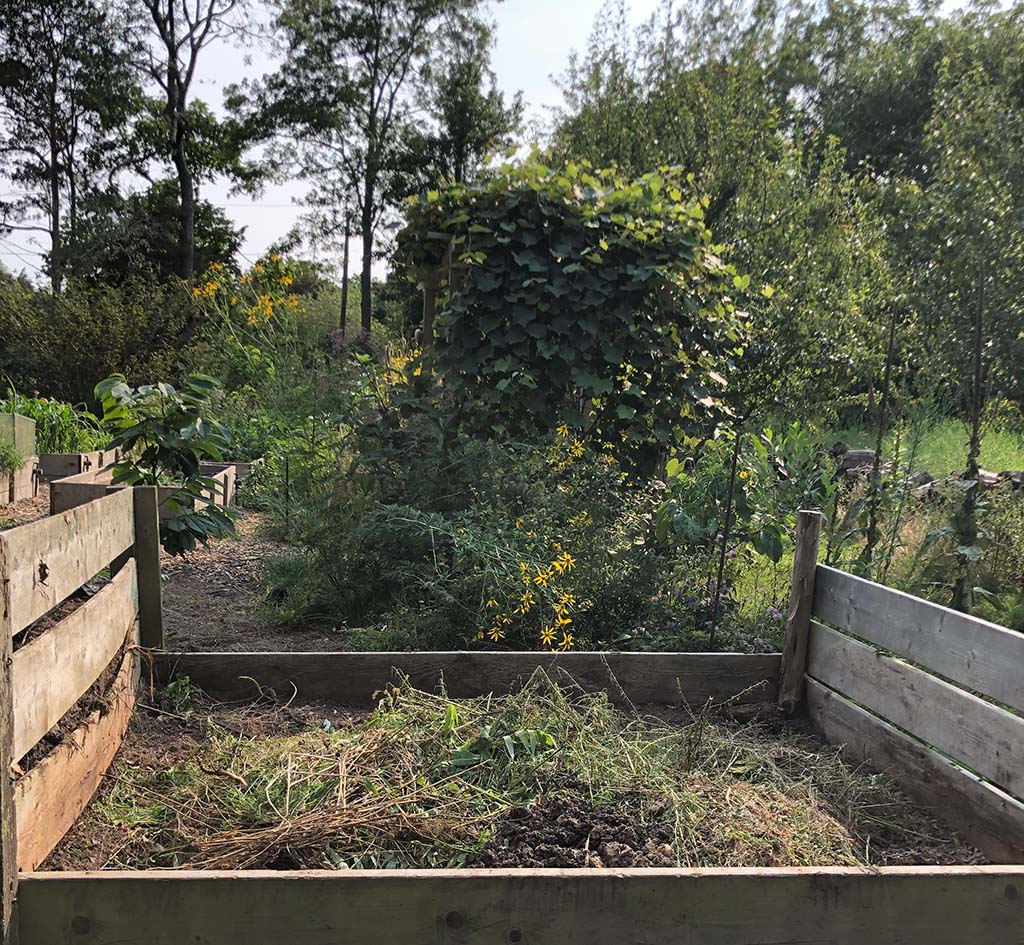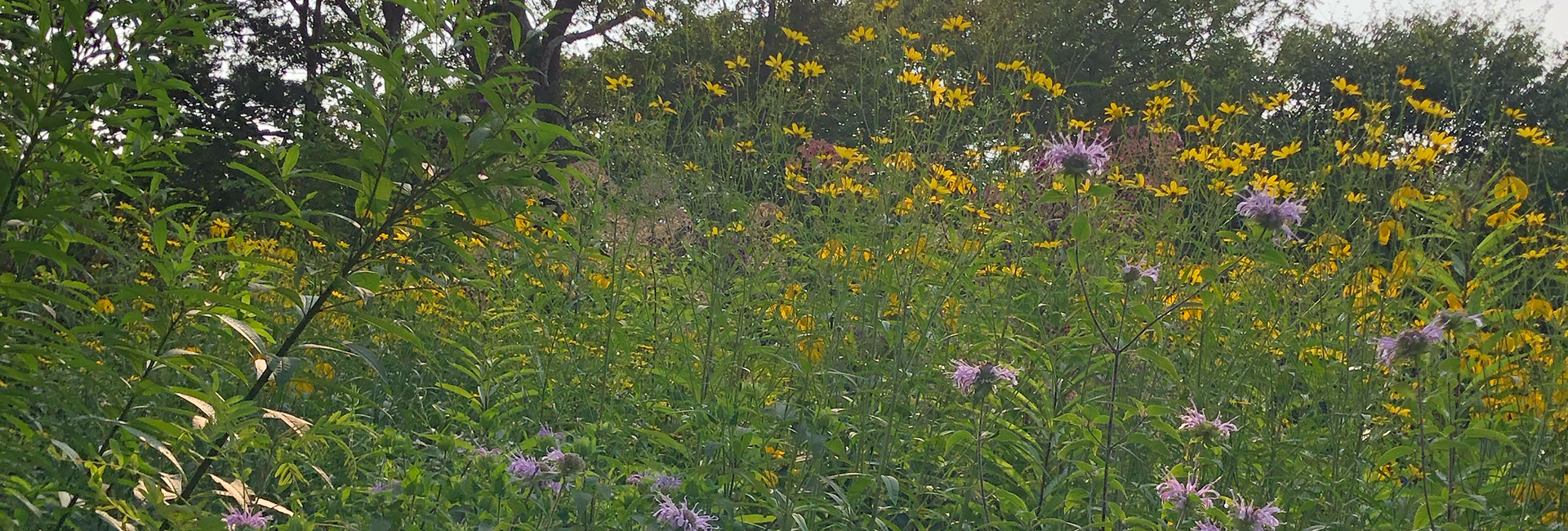Compost
Maintain Biomass: Close the Food Loop
We hear a lot about biomass and its importance to our gardens, but what is it and what is it important?
Biomass is organic matter produced by your garden: all the leaves, stems, and wood that come from plants. When biomass decomposes, it becomes free fertilizer—food for your plants. This is the perfect closed loop system: decaying plant matter feeds the soil, which in turn feeds plants. Instead of paying a landscaper to send grass clippings, leaves, and woody matter to the landfill, keep them, compost them, and feed them back to the plants that made them. Instead of buying foreign and synthetic products—fertilizers and mulch products—use what you have, for free, right on your property. Use mulching blades on your mower to finely chop grass and some leaves. (Leave the rest for the insects.) Spread chopped leaves over bare soil, make walls with logs, or make habitat piles with twigs, paths with wood chips. Be creative! And compost the rest.
Leave the leaves. Don’t send leaves (or grass clippings and woody debris, for that matter) to the landfill. Keep them on your property and feed them back to the plants that made them.
Mulch. Rake leaves under shrubs and trees in planting beds like mulch. They’re vital for wildlife and pollinators.
Feed. Use a mulching kit attached to your mower. It will finely chop grass and leaves, creating free fertilizer to leave directly on your lawn. You can also collect mulched leaves and grass to spread on bare soil and garden beds like mulch. You won’t need synthetic fertilizers or mulches again.
Repurpose. Make habitat piles from twigs, build walls with logs, create paths from wood chips. Be creative! And compost the rest.
How to Make Compost
To make compost mix green materials (nitrogen)—kitchen scraps and garden cuttings—with brown matter (carbon)—leaves, twigs, wood chips, and leftover soil. Opt for a ratio, roughly of 1 (green) to 3 (brown). Start a pile of these materials. To help it break down faster, chop up the material that you add, keep the pile moist (not wet), and aerate it by turning it with a shovel or fork about once every couple of weeks. Since most home compost piles never get hot enough to kill weed seeds, remove any seed heads before adding them to your compost heap. Look for a commercial composting facility that will get hot enough to kill weed seeds or throw them in the trash.
You’ll know your compost is ready when it looks dark and crumbly and there are no woody bits left. Compost is organic matter (not soil), so do not use it alone for filling raised beds or planters. Instead, use it to cover bare patches, topdress or mix into new beds (to enrich the soil)—it’s especially good for vegetable gardens—, and spread a thin layer on the lawn (to feed it).
Materials to Include:
Green
- Garden clippings
- Grass clippings
- Fruit and vegetable scraps
- Coffee grounds and tea leaves
- Crushed egg shells (add only sparingly)
Brown
- Dried leaves
- Twigs
- Woodchips
- Black-and-white newsprint
- Cardboard (remove tape and labels)
- Soil
Materials to Avoid:
- Plant material treated with chemicals
- Diseased plants
- Invasive plants
- Animal or fish bones
- Fats and oils
- Processed foods
- Glossy paper printed with color ink
FAQ
1. Why should I compost?
Every year, the U.S. sends approximately 167 million tons of waste to landfills annually; 50% of it could be composted instead [1]. When you compost, you reduce the amount of waste being sent to landfills and as a result reduce the amount of methane, a powerful greenhouse gas, emitted into the atmosphere. According to the Environmental Protection Agency (EPA), composting “lowers greenhouse gasses by improving carbon sequestration in the soil and by preventing methane emissions through aerobic decomposition [2].” You’re also creating something good for your garden. It’s a win-win.
- https://ilsr.org/wp-content/uploads/2019/04/Compost-Impacts-Poster.pdf
- https://www.epa.gov/snep/composting-food-waste-keeping-good-thing-going
2. Do I need a composter?
No, the good news is that you don’t need to buy anything to compost. Here is a breakdown of options:
- Piles: You can heap everything in one place, and either let it go or turn it as your time and energy allows. (To collect the finished compost, simply push the pile aside at the edges and scoop it from the bottom of the pile.) Since very large piles take longer to decompose (less oxygen) than smaller ones, it’s best to create multiple ones, if space allows.
- Bins: Build enclosures to contain piles. It will help you look and feel organized. Take note: Most prefab bins are squares, which can make it difficult to reach in and turn the pile. Look for options with a removable or open side for easy access. Wire cages allow for air flow in your bins, but be careful when you use a spading fork (preferred tool for turning). The tines can get stuck in the wires, which can be very frustrating.
- Multiple Bin Configurations: If you have the space, opt for a 3-bin system. Dedicate one for new material, a second for mid-process, and a third one for finished compost. You can move the compost from bin to bin as it matures, or you can simply stop adding to a bin when it gets full and move on to the next. Ideally, by the time the last bin is full, the first one is ready to harvest—although this will depend, of course, on the size of the bin, how much material you add, and how often you turn it.
- Closed Bins: There are many styles available at nurseries and online garden retailers. These can be rodent-proof, odor-free, space-saving, self-aerating. There are even some that can even take meat, fish, dairy, and other chunky, stinky stuff. If you opt for a closed bin system, be sure to add plenty of “brown” matter (leaves, wood chips, sawdust, clean shredded paper, cardboard). Turning is suggested, but not essential. One downside to consider is that many of these systems are made of plastic and are shipped from overseas.
- Contraptions: Rotating bins are another type of closed system. The concept seems solid: turning a handle is easier than turning a pile with a fork. But beware that many are too small for most needs. If you go larger, they can be very heavy to turn. Also, at some point you need to stop adding material in order to let the material “cook” into compost. If you do opt for one of these systems, buy or make two or more of them. For example, you can use two barrels and roll them around to aerate. Skip any that require the purchase of proprietary activator pellets. This is contrary to the concept.
- Vermiculture: Worm bins are fun, but fussy. You place worms (often red or red wiggler worms) in a bin filled with bedding material (newspaper strips and/or leaves) and feed them kitchen and garden scraps as well as brown organic matter. The worms eat and their waste becomes nutrient-rich compost. To be successful, bins need to be located in a warm, shady spot, out of strong direct sun. If you’re seeking something low-maintenance, try one of the other options above.
3. What about rodents?
Rodents should not be a problem if you turn your compost pile frequently. If you rarely turn it, don’t put “food” (kitchen scraps) in the heap, or use a rodent-proof closed bin system instead.
4. Should my compost smell?
Compost should only smell deliciously earthy. If yours smells bad, it means that your pile isn’t getting enough air. It is anaerobic decomposition that stinks. Kitchen scraps add a lot of moisture and can get anaerobic and smelly (not to mention attractive to rodents), so turn your pile often, incorporate more brown matter, or use a closed bin system.


